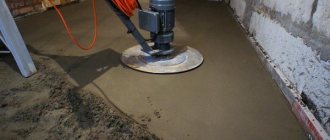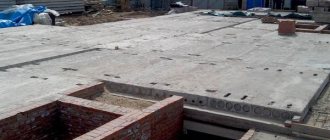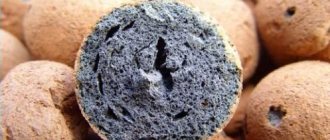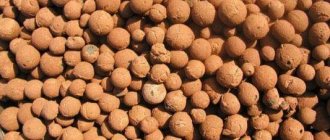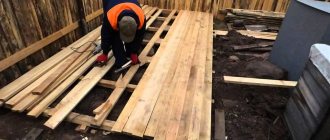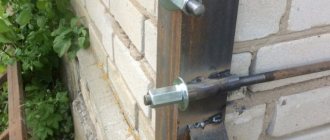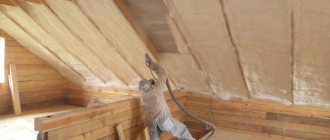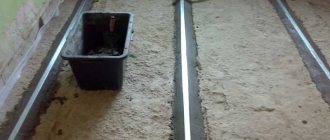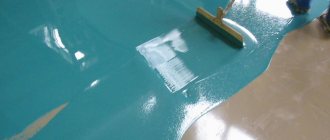The design of any floor requires the presence of a rough covering, which in apartments of multi-storey buildings is done using a screed. The screed can be done wet or dry. The second method of creating a rough foundation in the form of a bulk floor is becoming increasingly popular due to the short installation time of such a covering. Concrete screed requires a long time to dry completely. The leader of the modern market in this segment of building materials is the German Knauf floors. Do Knauf loose floors have any disadvantages and when can such a coating be used when renovating an apartment?
Advantages of expanded clay screed
If you compare expanded clay screed with traditional concrete, you can find only one serious drawback: the impossibility of laying a thin layer, which can be important for low ceilings. The disadvantages could also include lower strength than concrete, but it is quite sufficient for residential premises.
But screed with expanded clay has many advantages. These include:
- floor insulation on any base - soil, reinforced concrete slab, wooden flooring. And, as a result, increased comfort and reduced costs for heating the house;
- ensuring sound insulation between floors;
- the ability to level out any level differences;
Such a screed can cover differences of up to 10 cm or even more Source chonemuzhik.ru
- reducing the cost of leveling the base;
- the possibility of laying on insufficiently strong and reliable foundations, since expanded clay screed is much lighter than cement screed and therefore does not create a large load;
- the possibility of laying communications under the floor in a thick layer of screed.
All this together makes expanded clay rough coating much preferable to concrete. There is only one limitation for its use - this is the high probability of moisture getting into the thickness of the dry screed. That is why it is not recommended to install a water heated floor in it. Expanded clay gets along well with electric and infrared.
For reference! Expanded clay itself is not afraid of water and is not destroyed by its influence. But stagnation of moisture is dangerous due to the appearance of dampness in the house and the formation of mold.
Do-it-yourself loose floor - step-by-step instructions
Categories: Articles
When starting to renovate a room, special attention is always paid to materials. The most in demand are those that can be used without the involvement of specialists, as well as those that are easy to install and affordable.
The world of modern building materials is so diverse that there are always plenty of proposals to implement any solution and the most diverse needs.
Manufacturers are so interested in satisfying their customers that they are constantly improving and offering more convenient, optimal and rational material options every day.
One of these solutions for arranging the floor was the release of dry screed, the installation technology of which is simple and accessible to anyone who decided to make a bulk floor with their own hands.
What is a loose floor, how to choose materials, what tools are needed for this and how to arrange the floor - the answers to these questions are presented below.
Varieties of expanded clay
Floor screed with expanded clay is performed in different ways, which can be divided into dry, wet (traditional) and combined. For each of them, the material is selected individually. More on the methods below, but for now let’s figure out what expanded clay is and what properties and characteristics it has.
Expanded clay granules: dense on the outside and porous on the inside Source ec-nn.ru
The basis of the material is clay with special additives. The raw material is subjected to high-temperature firing, as a result of which it swells with the formation of many small closed voids inside and a dense crust on the surface. This porous structure allows the use of expanded clay as insulation with unique properties. With a sufficiently high density and strength, it is lightweight and resistant to moisture.
Depending on the production method, shape and size of individual particles, the material is divided into 3 types:
- expanded clay crushed stone, the main difference of which is the irregular shape of particles 0-40 mm in size, obtained by grinding large stones;
- expanded clay sand, consisting of round granules less than 5 mm in diameter;
- Expanded clay gravel is also a mixture of oval or round granules with a diameter of up to 40 mm. It can be homogeneous, from granules of 5-10, 10-20 or 20-40 mm, or it can consist of elements of different sizes.
Some types of expanded clay Source 1nerudnyi.ru
Note! Grain sizes and other characteristics of the material are regulated by GOST 32496-2013. Manufacturers producing it according to their own specifications cannot guarantee quality.
This bulk material also differs in density, which depends on the size of the granules and voidness. The lower these indicators, the greater the weight.
For thermal insulation, expanded clay flooring in the form of crushed stone or gravel is used. Sand is not suitable for this, as it has a high density. It is used when it is necessary to level bases with large differences in level or damaged surfaces as a material that gives less shrinkage.
Leveling the insulation surface
Surface leveling is carried out using two beacon guides and one leveling rod. The guides are placed parallel to each other at the width of the leveling rail. The guides are installed on a layer of expanded clay, and the installation level is checked along the entire length using a laser level. In this case, the installation accuracy should be as high as possible. After the guides are set, expanded clay backfill is poured between them. Using a leveling rod or rule, the level of expanded clay is leveled to the level of the guides. At the same time, if necessary, add the missing or remove excess expanded clay. After the strip between the guides is aligned, they are rearranged further and the process is repeated. The result should be a smooth surface of the insulation.
Methods for installing expanded clay screed
Expanded clay for leveling and thermal insulation of bases can be used in bulk form or as a filler for a pouring mixture. Depending on this, the technology of work also changes.
Wet method - traditional screed
Expanded clay concrete screed is made in exactly the same way as a classic screed, from a sand concrete mixture. It’s just that not ordinary crushed stone or gravel is used as a filler, but expanded clay. It allows you to seriously lighten the load on the floors when the thickness of the screed is needed: about 50 kg for every square meter with a thickness of 5-6 cm.
Finished rough coating Source chudopol.ru
See also: Catalog of house projects presented at the Low-Rise Country exhibition.
In this case, the fractionation of the material is not particularly important, since the voids will be filled with sand, and all components of the solution will be bound into a monolith. Therefore, you can take both crushed stone and gravel, focusing on the availability and cost of the filler. Typically, crushed stone is cheaper due to its lower density and weight.
It is also worth considering that the smaller the size of the aggregate granules, the smoother the surface will be. The layer with large crushed stone will probably have to be leveled additionally with cement mortar, making a finishing screed. A layer of gravel may well serve as a ready-made base for laying tiles, but you cannot lay linoleum or laminate on it - you will also need to level the surface.
Advice! When using coarse aggregate for screeding on the ground, its surface must first be leveled and compacted, without leaving significant unevenness and dips.
The composition of expanded clay concrete, the proportions per 1 m3 depend on the brand of cement used and the requirements for the strength of the base. For a house or apartment, an approximate ratio of M400 cement, sand and expanded clay is usually used: 1: 3: 2. This composition provides a grade of screed M50-M100 sufficient for domestic conditions, taking into account the laying of the finished floor covering.
What should you give preference to: Knauf backfill or expanded clay with a fine fraction?
Highly qualified plant technologists constantly improve production by conducting a large number of laboratory tests. The materials tested were expanded clay and expanded clay sand. Expanded clay was purchased from various domestic suppliers. During the study, it was possible to find out that expanded clay did not meet the required standards and parameters.
Backfill Knauf
Today we can say with certainty that the highest quality expanded clay sand is produced only in Belarus. It is this sand that the Knauf company uses to make dry backfill for floors.
The technical characteristics of Knauf dry backfill include the following advantages:
- the height of the backfill is about 2 cm;
- per 1 sq. m of floor you will need 10 kg of backfill (1 cm layer);
- bulk density is 600 kg per 1 cubic meter;
- the strength of the material is 2.5 MPa.
- Features of dry floor screed
No more than 1-2 days pass from unloading the material until the completion of the work
The process of dry floor screeding is quite simple. The step-by-step execution looks like this:
- cleaning the concrete base of the floor from dirt;
- applying a layer of dry backfill;
- laying sheet material.
It is worth clarifying that wooden logs can be successfully used as a basis for a dry field.
Dry floor screed
Why do most developers prefer this type of floor backfill? What are their advantages? The main “highlight” of a dry floor is the organization of this process itself. Here you do not need a concrete mixer and other “wet” pouring tools. This allows you to significantly reduce labor costs. The work cycle itself proceeds much faster. All this together gives easier access to the installation of various communications, increases the heat-protective potential of the floor and its sound insulation.
Dry screed in the apartment
Dry floor screed is used in most cases for:
- improvement of old buildings;
- rapid execution of construction work;
- in winter, as the concrete hardens;
- laying wooden floors.
Before you begin work on arranging floors using dry screed, you need to remember that such work is carried out after the completion of the planned plumbing work and electrical, water supply and heating activities.
Video description
You can study the technology of installing a screed made of expanded clay concrete using the video:
The work consists of several stages.
- First, the level to which the floor rises is marked along the walls. To do this, it is most convenient to use a laser level.
- After removing the old floor covering and clearing away the debris, the holes in the ground are filled and compacted, large cracks, gaps along the walls and joints between the slabs are sealed - the preparatory work depends on the material and condition of the base.
- The next stage is waterproofing. It is needed so that moisture does not leave it during the hardening process of expanded clay concrete. And also to prevent leaks from wet mortar to the lower floors. In the case of a ground screed, the waterproofing also serves as a barrier to groundwater. It is made from thick film, roofing felt or fiberglass, always laying the material with an overlap of at least 10 cm and gluing the joints with tape. Concrete bases can be insulated with liquid compounds - waterproofing, liquid rubber, etc. The waterproofing layer should be continuous and extend vertically onto the walls above the marking level.
Waterproofing under screed Source sam-sebe-dizainer.com
See also: Catalog of companies that specialize in the design and construction of turnkey country houses.
- If electrical cables are laid along the floor, they are also wrapped in film and wrapped with tape.
- Next, the beacons are installed, fixing them with cement mortar or alabaster. The distance between beacons should be no greater than the length of the rule.
- Along the entire perimeter of the walls along the marking line, damper tape is glued or secured in any other way. It neutralizes the thermal expansion of the screed and serves as sound insulation. You can use either ready-made self-adhesive tape or other suitable materials - for example, strips of polystyrene foam.
- Then expanded clay concrete is prepared, the proportions of which are selected in accordance with the strength requirements. In the case of an insulating screed and laying a hard floor covering on top of it, it is allowed to double the amount of expanded clay.
Proportions of components for obtaining a solution of different brands Source remoo.ru
- When making a solution, it is recommended to first fill the expanded clay with water so that it absorbs moisture and does not float to the surface of the screed and does not pull it out of the solution. Then add the remaining components - cement and sand or a ready-made sand-cement mixture.
- If the thickness of the screed exceeds 60-100 mm, then it is poured in 2 layers with a minimum soak time between layers. It is best to divide the room into squares and fill each area in 2 steps, then move on to the next one.
- If the screed is without a leveling layer, then the solution is pulled out according to the beacon rule. In the case of a cement screed, leave space for it - at least 2-3 cm to the upper level of the beacons, and the expanded clay concrete is leveled by eye.
- After the initial setting of the solution, the beacons are removed, and the resulting depressions are sealed with fresh solution.
Beacons are removed until the solution has completely set Source polonest.ru
Video description
The entire process from backfilling to laying the coating is shown in the video:
Advice! It is better to start backfilling from the far wall and move towards the exit, and laying gypsum fiber boards in the reverse order. But you can carry out the installation in small sections or move along a temporary gypsum fiber board flooring thrown onto the expanded clay.
Combined method - type-setting screed
Something in between the described options is a screed on expanded clay, poured onto the base in a thick layer. To ensure effective thermal insulation, the thickness of the backfill layer must be at least 100 mm and consist of gravel of different fractions. If only leveling with raising the floor level is required, the layer of dry expanded clay may be smaller, and the backfill may consist of fine crushed stone and sand.
Installation of a wet screed over a dry screed Source www.baurum.ru
So, screed with expanded clay – the technology for its production with all its variations:
- as usual, the first step is to mark the level and prepare the base;
- expanded clay is poured and distributed so that there is room for a cement screed (usually at least 20-30 mm);
- so that the backfill does not float up into the screed, the expanded clay layer is filled with cement laitance - a liquid solution that should seep between the granules and hold them together;
- a day later, beacons for a wet screed are installed on the set layer;
- Between the layers you can lay a reinforcing mesh, which is important for large areas, or a thick polyethylene film, which will prevent the expanded clay from sucking water out of the solution. In this case, there is no need to spill the backfill with liquid solution.
Tools and materials
To perform high-quality work on installing a bulk floor made of expanded clay and gypsum plaster sheets, you will need the necessary set of tools:
- tape measure and marker;
- laser level;
- usual high-quality construction level;
- perforator;
- screwdriver with attachments;
- jigsaw;
- drywall knife;
- square or metal ruler;
- roughing plane for edges;
- construction stapler;
- guides for beacons made of aluminum or galvanized profiles;
- rule or leveling rod;
- bucket and shovel;
- vacuum cleaner;
To install a dry gypsum fiber floor, you will need materials that must be purchased in advance and delivered to the site. For the screed you will need:
- 80 micron thick polyethylene film for vapor barrier;
- edge tape 100 mm wide;
- PVA glue;
- self-tapping screws for drywall 19 mm long;
- expanded clay backfill Compevit with granule sizes of 1-4 mm;
- sheets of dry Knauf screed;
- putty Knauf
The amount of material required is calculated based on the floor area of the room and the thickness of the backfill. Anyone can easily perform all these calculations for their apartment themselves, knowing the length and width of the rooms and the corridor. It is worth noting that the material must be purchased with a small margin, based on the fact that during the installation process there will necessarily be cuttings of slabs and the thickness of the screed at different points may differ.
